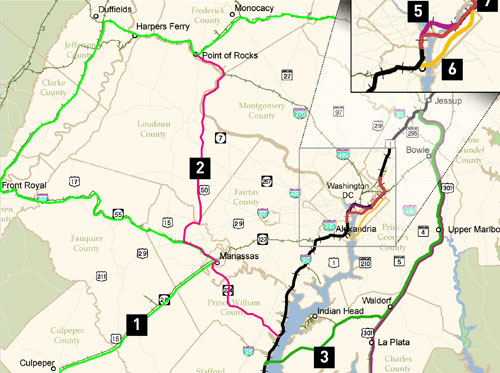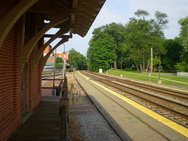Gaithersbungle, part 3: What else can you get for $3.8 billion?
The Montgomery County Planning Board staff endorsed a $3.8 billion widening of I-270 all the way to Frederick County, a move which would fuel sprawl way up in the county’s preserved farmland areas. What else could we do with $3.8 billion to improve the corridor even more?
We can start with the transit that’s already there. There’s a rail line that stops in all the towns along the way: MARC. For less than $3.8 billion, we could realize a vision like this, of Metro-quality services on all MARC and VRE lines.
The main obstacle is that CSX owns the tracks, and uses them for freight. However, NCPC commssioned a study on the feasibility of moving CSX’s freight traffic off the main line through DC. They found that for about $2 billion, we could construct a bypass through Bowie, Upper Marlboro, and then across the Potomac to Stafford County, largely using rail right-of-way that already exists. That would relieve VRE and the MARC lines from Baltimore, but not the MARC Brunswick line along 270. However, the study also evaluated a western bypass from Point of Rocks through eastern Loudoun, and there’s also an existing set of alternate tracks that go even farther west, through Front Royal, into Manassas, and back out to Culpeper and Gordonsvile, Virginia. For $3.8 billion, we could probably build both bypasses, or route Brunswick freight traffic over the existing lines, and free up the MARC line for real transit-quality service.

Potential alternative corridors for freight rail through the region.
Image from the Freight Railroad Realignment Feasibility Study.
Or, we could build a new line, like the one Dave Murphy suggested to Frederick. Such a line ought to stop more frequently in the Rockville-Gaithersburg area, however, if the County really wants to foster more transit-oriented development there instead of just pushing northwestern sprawl.
And for far, far less money, we could improve the immediate area. ACT’s Ben Ross pointed out today that the difference in cost between BRT and light rail on the Corridor Cities Transitway would be $200 billion million. And meanwhile, down around the White Flint area which is already dense and near transit, the Planning Board said it was too expensive to spend $70 million to make Rockville Pike more usable for pedestrians, bicyclists, and bus riders.
The best argument of all comes from the freeway-cheerleading Washington Post itself (which never mentions the Intercounty Connector without words like “desperately-needed,” even in an obituary for someone who fought the plan. The last time Maryland widening I-270 was in the 1980s, for what now sounds like a paltry $200 million. Rather than reduce congestion, the widening simply fueled sprawl that filled the road right up, and all Maryland got for its $200 million was even more vehicle miles traveled, people living even farther from jobs, and less rural land at the edge of the county.
Planning staff are eager to make the very same mistake again. “Most planning agencies … don’t really account for induced demand,” Princeton professor David Bernstein told the Post ten years ago. It seems these agencies still haven’t learned a thing.

